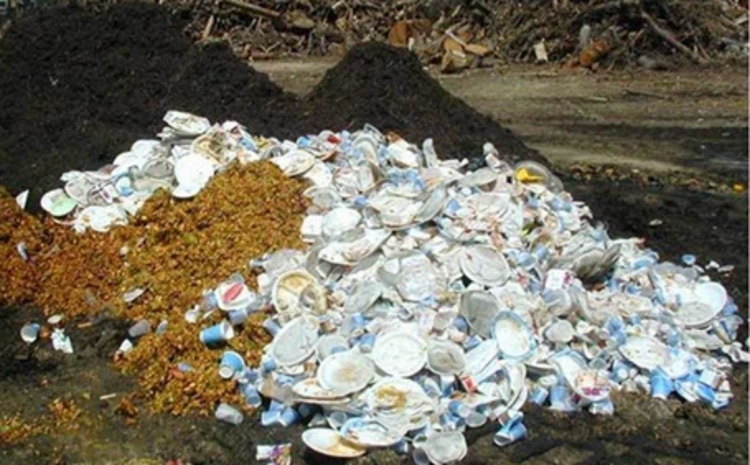The future of compostable packaging is bright

A multi-pronged, multi-stakeholder systems approach is needed to fully realize the potential of compostable packaging. Here are three areas to focus on, along with next steps.
Earlier this year, I took a look at the rise of composting as an end-of-use solution. Certainly the future of composting and compostable packaging are bright, though the pace of growth remains frustratingly slow.
Large-scale composting has the potential to take approximately one-third of the municipal solid waste stream out of landfills, benefiting the economy, retaining resource availability and addressing climate change impact. Food waste comprises more than 10% of the U.S. waste stream, making it the third largest component.
However, very little food waste (5%) is diverted. Many paper-based packaging products are not accepted in recycling streams because they are wet or contaminated by food. Additionally, many foodservice operations are choosing bio-based and/or compostable packaging, either by choice or because of municipal regulations. Source separation of organics and compostable packaging removes what would otherwise be non-biodegradable contaminants to recycling or landfilled waste, opening the opportunity to build a robust food and packaging composting capacity.
As we wrap up the final report for one of the Sustainable Packaging Coalition’s “on-the-ground” projects with a compost focus, we have been able not only to increase food and compostable packaging waste diversion in the area, but also glean a number of best practices as they relate to both composting overall and compostable packaging.
As with all of our material challenges, a multi-pronged, multi-stakeholder systems approach is needed to fully realize the potential of compostable packaging. These include:
1. Policy Approaches: Both voluntary and mandatory approaches are detailed, to include case studies, in the EPA’s recently publishedManaging and Transforming Waste Streams Tool for localities. It is an excellent resource that includes examples such as zero waste goal-setting, requirements for recyclable and compostable packaging, and landfill bans on organics.
2. Outreach and Education: Localities, composters, non-profits and compostable packaging manufacturers and brands can all help answer these critical questions:
• Why? In absence of strong policy drivers, why should an organization divert its food and compostable packaging waste?
• How? A number of toolkits are now available to help with this question within a number of sectors, but a national resource is needed.
• What? Particularly for packaging, this piece is critical to reducing and/or eliminating contamination.
3. Contamination: We have to drive home the idea that recyclers and composters are not merely waste disposal services, but also manufacturers looking to create a viable product. As with recycling, the more contamination that occurs, the less valuable the product and more expensive the process.
Related also to outreach and education, it remains imperative that companies not only clearly label and identify compostable packaging, but also take the high road and resist the urge to design a package that looks compostable but isn’t.
There are multiple examples: non-compostable plastic bags and liners colored green; an off-white clamshell that looks like the compostable bagasse type but is actually polypropylene; a foodservice brown folding carton with every type of green claim imaginable, leading most consumers to think it is compostable; off-white utensils called “biodegradable;” and a poly-lined fiber cup that has a green stripe quite similar to the brown/green stripe used by many compostable types. The U.S Composting Council has a critical guide on how to label certified compostable packaging. Related to this is the important question of how should these confusing packaging issues be handled?
Data and measurement
Trash pick-up is such a ubiquitous part of the American experience. We seldom question how much waste we are generating or, particularly in the workplace, the structure of our waste pick-up contracts.
However, waste audits have increasingly been shown to be a valuable way to put waste generation front and center. A waste audit at one of the SPC’s local composting projects has shown that, with a switch to compostable packaging, 90% of the material generated at a weekly event is recyclable or compostable, coming close to achieving zero waste.
On the commercial side, if waste hauling contracts are set up to provide and be billed by tonnages, as opposed to number of pick-ups, then reductions in waste are much easier to translate into reductions in cost. In the consumer side, this is the “pay-as-you-throw” concept.
We must recognize the inherent value in a package design with a positive sustainability story in terms of sourcing and life cycle, even though the end-of-use availability is not yet widespread. Indeed, compostable packaging is unique in that it is part of the technical cycle but interfaces with the biological cycle, able to enhance the health of our soils, thus contributing to the ideal circular economy.
Next steps
Last month, Adam Gendell pointed out that the inconvenience of recycling is a key detriment to increasing recycling rates—not consumer apathy. It follows that convenient ways to sort compostables and clear messaging are also necessary, and that many people will take the time to understand their system and what to do with their waste. To take advantage of that interest and the need for clear instructions, the SPC continues to work on development of the “How2Compost” label, an offshoot of the growing How2Recycle Label Program.
A group within the SPC is also looking at projects to more clearly define and ensure the key role of compostable packaging in the food waste and composting cycle. The SPC has provided a critical bridge from designers to recyclers, and we look forward to continuing this work with our growing number of members that have an interest in compostable materials and packaging.

Anne Bedarf is a senior manager with GreenBlue’s Sustainable Packaging Coalition. For additional information about the Coalition and the How2Recycle Label, please visit www.sustainablepackaging.org and www.how2recycle.info.
_______________________________________________________________________________________
See a host of new ideas in packaging machinery, materials and more at SouthPack 2015, Nov. 18-19, in Orlando, FL.
_______________________________________________________________________________________
About the Author(s)
You May Also Like


